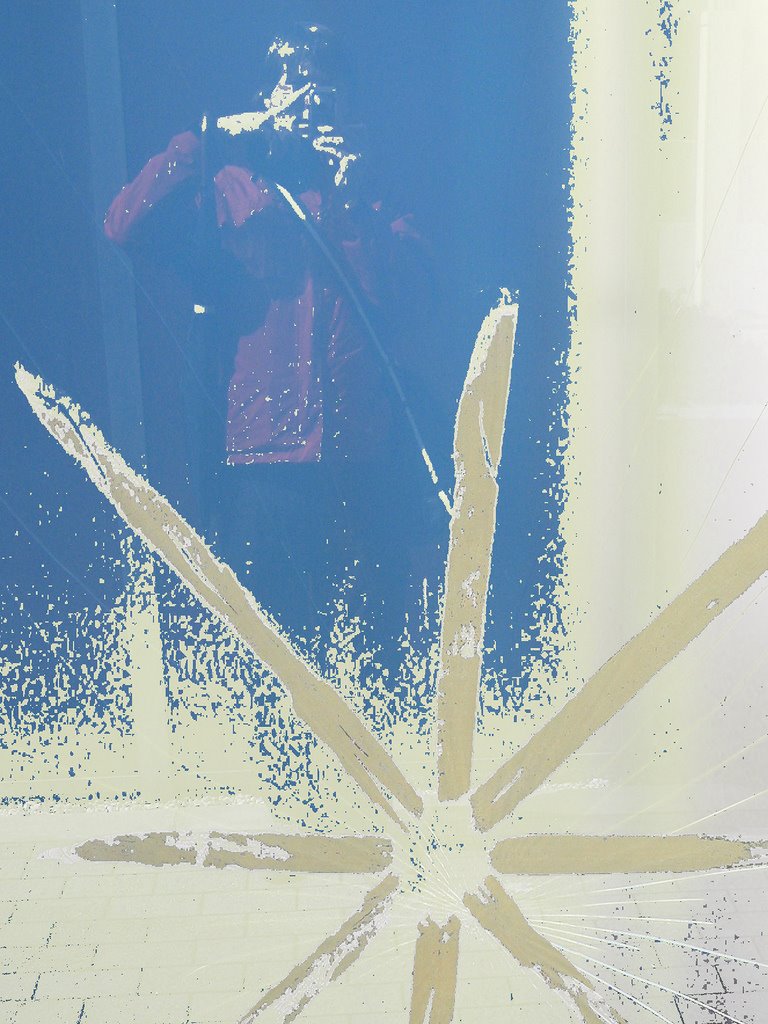 Being not that tourist-mekka, Chiba has its sights, such as Chiba-Castle, a zoo and the Port Tower, all of these linked by Chiba Urban Monorail, worlds longest suspension type monorail. Most of the day i spent at the port area, which is one of the largest in all of Japan. Just some minutes walk from Minato Station there's a small piece of green in midst the never to end industrial architecture spreading along the eastern coastline!
Being not that tourist-mekka, Chiba has its sights, such as Chiba-Castle, a zoo and the Port Tower, all of these linked by Chiba Urban Monorail, worlds longest suspension type monorail. Most of the day i spent at the port area, which is one of the largest in all of Japan. Just some minutes walk from Minato Station there's a small piece of green in midst the never to end industrial architecture spreading along the eastern coastline!Just at the waterfront of this recreational area, there is the port-tower, a slender building of 112m height.
 Still not totally gotten used to outdoor background music, i stood in its shadow amazed and listened to jazzo-electrified popsongs (something that met my liking at last). I went it up of course, trying not to mind looking down 112 meters through a translucent glass- and steel construction. But you also have a great view over all the vast commercial area, up to Tokyo where buildings slowly disappear in the fume. Ships coming in and going out again, waking some wanderlust in me just at the other end of this beautiful earth.
Still not totally gotten used to outdoor background music, i stood in its shadow amazed and listened to jazzo-electrified popsongs (something that met my liking at last). I went it up of course, trying not to mind looking down 112 meters through a translucent glass- and steel construction. But you also have a great view over all the vast commercial area, up to Tokyo where buildings slowly disappear in the fume. Ships coming in and going out again, waking some wanderlust in me just at the other end of this beautiful earth. Outside people were taking advantage of the accessible waterfront. At a small renaturalised bay surrounded by a factory- and silo-landscape, people were relaxing, surfing, fishing crabs (leaving aside the flying fish, which are lots of fun to watch) and looking for seashells (me too!). Still not having had enough of industrial coastline, i went on a boat, that did the port tour, allowing me to experience the view from the seaside.
Outside people were taking advantage of the accessible waterfront. At a small renaturalised bay surrounded by a factory- and silo-landscape, people were relaxing, surfing, fishing crabs (leaving aside the flying fish, which are lots of fun to watch) and looking for seashells (me too!). Still not having had enough of industrial coastline, i went on a boat, that did the port tour, allowing me to experience the view from the seaside. I went back again by the monorail, stopping at Chiba Park to relax a bit, before continuing to the city center to experience Chiba after nightfall. In fact, by then the scenery totally changed. And daytime-commuters giving way to a more younger townsfolk looking for entertainment. Finally I let myself convince once more by some crazy background outdoor free jazz, to look for the place where they had that. But in vain. All in all I had quite a hard time getting a simple drink! That's because on ground floor, there are mostly shops. Clubs and bars, are on higher floors, so no strolling by, checking if the place is what you're up to right now. Instead there are panels in front of the elevators, turning out to be totally undecipherable for me, including signs saying pub, while the place turning out to offer some slightly different kind of leisure. I got my beer at last. In a restaurant.
I went back again by the monorail, stopping at Chiba Park to relax a bit, before continuing to the city center to experience Chiba after nightfall. In fact, by then the scenery totally changed. And daytime-commuters giving way to a more younger townsfolk looking for entertainment. Finally I let myself convince once more by some crazy background outdoor free jazz, to look for the place where they had that. But in vain. All in all I had quite a hard time getting a simple drink! That's because on ground floor, there are mostly shops. Clubs and bars, are on higher floors, so no strolling by, checking if the place is what you're up to right now. Instead there are panels in front of the elevators, turning out to be totally undecipherable for me, including signs saying pub, while the place turning out to offer some slightly different kind of leisure. I got my beer at last. In a restaurant.Link to the Foto-Map (Thanks go to Thomas here!)














